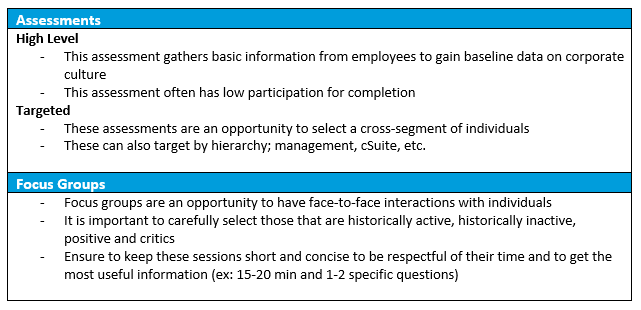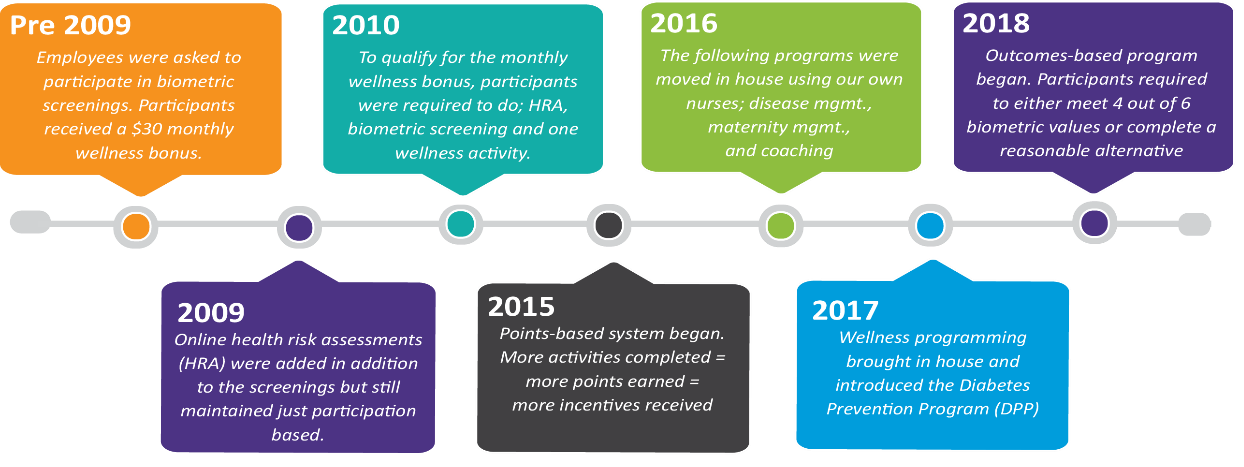Author: Ami Bolles, Wellness Expert
At Telligen, we understand there is not a one-size-fits-all approach when introducing health and well-being programming to your employees. Many employers have been there, done that and are still making improvements to their program. At Telligen, we have walked the walk which is how we can offer proven solutions that produce results both via health outcomes and financially. In this article, I will provide some insight on the importance of culture to build successful programming as well as share the Telligen wellness journey.
How to Get to Know Your Culture
There are various ways to get a pulse on your culture but I would recommend utilizing both assessments and focus groups. The chart below outlines each method.

In addition to the tools above, I encourage working with your broker/consultant to review your claims and biometric results to determine the most prevalent risks in your population. Combining the information gathered via assessments, focus groups and claims/biometrics data, you can better formulate a program to best meet the needs of your employees and provide them with the right tools for success.
Telligen’s Wellness Journey
To understand our journey, it is important to see our path to wellness and well-being. The timeline below describes the programs and services we have rolled out to our employees over the years.

Knowing Your Culture – Telligen’s Story
Telligen’s own journey of knowing our culture began with the assessments and focus groups discussed above. These methods greatly helped us to better identify and tailor programming to our employees. Below are just a few examples of learnings based on what we gathered:
Communications. Our employees emphasized a need to be communicated too often and clearly. Because of this, when we made the decision to move from participation to outcomes-based programming, we started communications planning an entire year ahead of time. We wanted to do our best to not alienate employees or the culture with calculated communications planning and timing. Employee communications about the change and impacts were delivered in a variety of mediums including; articles, posters and presentations with Q&A sessions to name a few.
Employee Interests. One of the assessments asked employees what their interests were and a common answer centered around bike riding, specifically in our Des Moines office location. Our Chief Medical Officer was one of those with a biking interest so he helped to form an organized biking group which meets regularly to go on rides. Even though participation in the group doesn’t earn wellness credit or incentives, the benefit of increased physical activity and team camaraderie has added to a more positive corporate culture.
Wellness Ambassadors. Through our assessment, it was obvious that our employees’ interests were unique not only by geographic location, but also within business units within the same office location. To address this and enhance our culture, we created our Wellness Ambassador program. We utilized employees who volunteered for the program to listen to their business units and help develop wellness and well-being activities and challenges to better engage participants. Many of the activities were approved to earn points that led to wellness incentives.
Getting an accurate snapshot of your employee base is essential to know and foster your culture. Getting a handle on the culture will only help to offer and deliver programming that will have the best impact on the health and well-being of your employees and the bottom line for you.
I hope you have gained a little more insight into culture and its impact on wellness and well-being programming for an employee base. We are making strides here at Telligen and look forward to continuing our journey.
